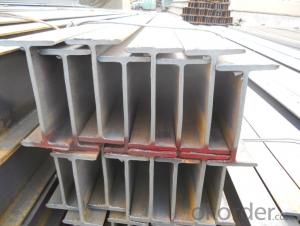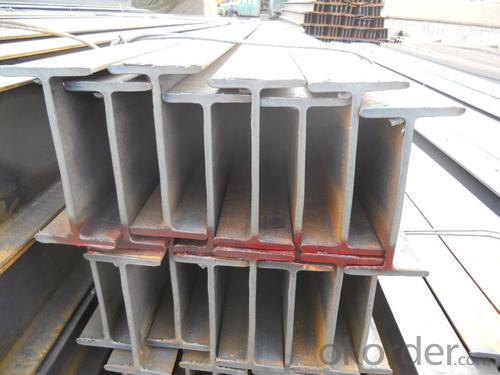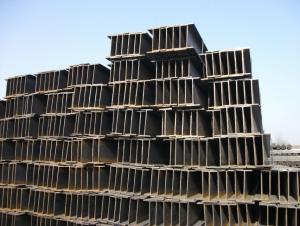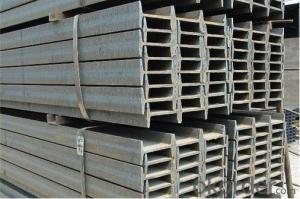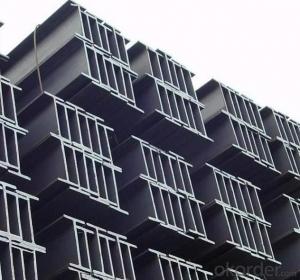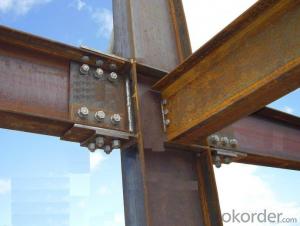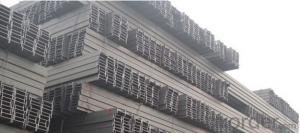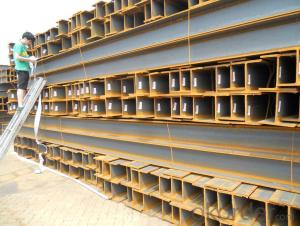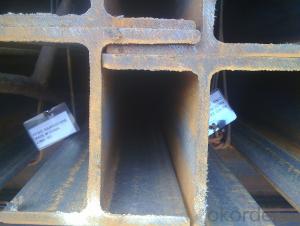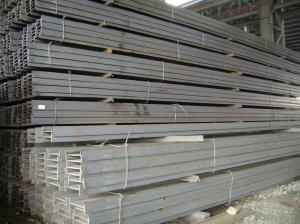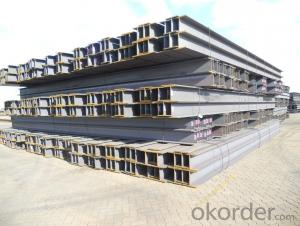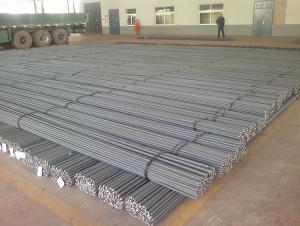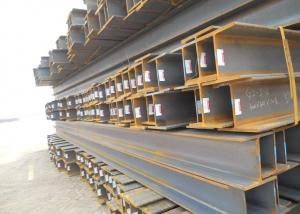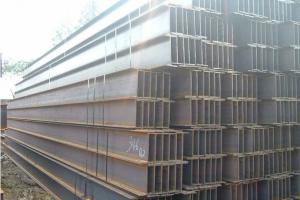Structural carbon steel h beam profile H iron beam (IPE,UPE,HEA,HEB)
- Loading Port:
- Tianjin
- Payment Terms:
- TT OR LC
- Min Order Qty:
- 30 m.t.
- Supply Capability:
- 28000 m.t./month
OKorder Service Pledge
OKorder Financial Service
You Might Also Like
Hot rolled H beam section
Product Description
1. Standard: GB, JIS, ASTM ST
2. Material: Q235, Q345, SS400, S235JR, S275JR, S355JR
3. Length: 5.8-12m or according to our clients' requirements
4. Origin: Tangshan, China
5. Package: load on 20 feet/40 feet container or by bulk according to the quantity and our client's requirement
6. Delivery time: within 20 days after receiving deposit or original L/C
7. Certificate: ISO, SGS, BV, CIQ or other test
8. Technic: Hot rolled
9: Surface: painted, galvanized or punch holes
10. Main market: East-south Asia, Mid-east, South American
11. Usage: Construction structure and Frame use
12. Other Main products: Angle steel, I beam and Channel steel
Specification:
H Type Steel Size and Theoretical Weight | |||||
Size (mm) | Theoretical Weight (kg/m) | Size (mm) | Theoretical Weight (kg/m) | Size (mm) | Theoretical Weight (kg/m) |
100*50*5*7 | 9.3 | 250*125*6*9 | 29 | 446*199*8*12 | 65.1 |
100*100*6*8 | 16.9 | 250*250*9*14 | 71.8 | 450*200*9*14 | 74.9 |
125*60*6*8 | 13.1 | 294*200*8*12 | 55.8 | 482*300*11*15 | 110.8 |
125*125*6.5*9 | 23.6 | 298*149*5.5*8 | 32 | 488*300*11*18 | 124.9 |
148*100*6*9 | 31.1 | 340*250*9*14 | 36.7 | 496*199*9*14 | 77.9 |
150*75*5*7 | 14 | 300*150*6.5*9 | 93 | 500*200*10*16 | 88.1 |
150*150*7*10 | 20.7 | 300*300*10*15 | 78.1 | 582*300*12*17 | 132.8 |
175*90*5*8 | 18 | 346*174*6*9 | 41.2 | 588*300*12*20 | 147 |
175*175*7.5*11 | 40.4 | 350*175*7*11 | 49.4 | 596*199*10*15 | 92.4 |
194*150*6*9 | 29.9 | 350*350*12*19 | 134.9 | 600*200*11*17 | 103.4 |
198*99*4.5*7 | 17.8 | 390*300*10*16 | 104.6 | 700*300*13*24 | 181.8 |
200*100*5.5*8 | 20.9 | 396*199*7*11 | 56.1 | 800*300*14*26 | 206.8 |
200*200*8*12 | 49.9 | 400*200*8*13 | 65.4 | 900*300*16*28 | 240.1 |
244*175*7*11 | 43.6 | 400*400*13*21 | 171.7 | ||
248*124*5*8 | 25.1 | 440*300*11*18 | 120.8 | ||
Length=6-12meters | |||||
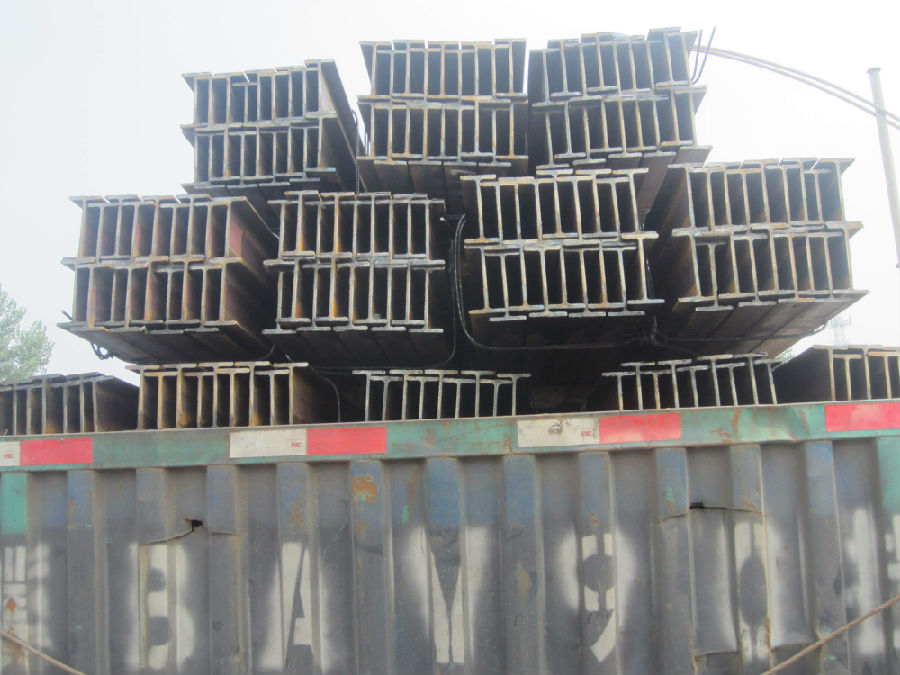
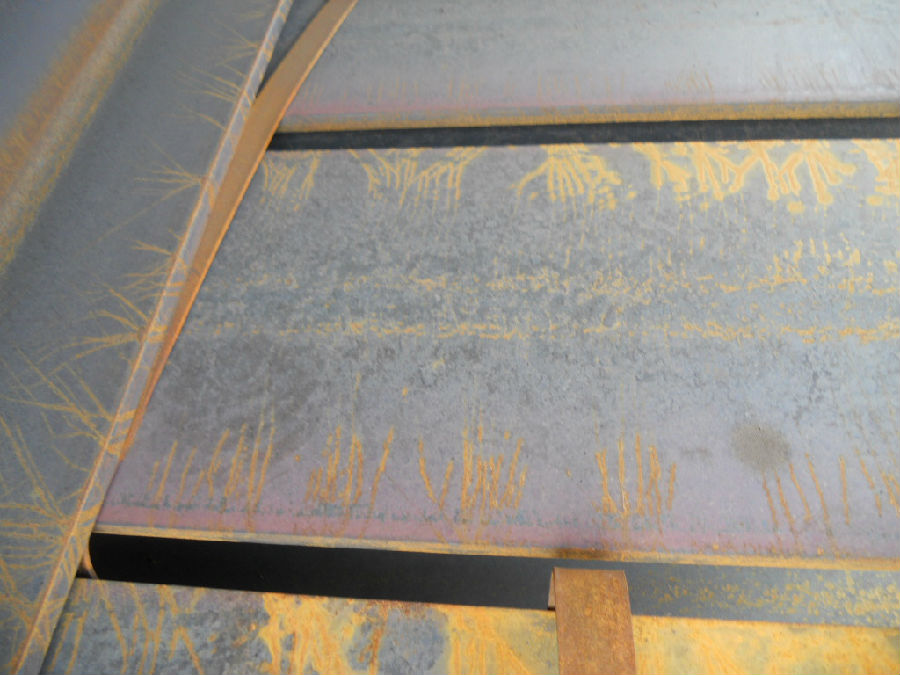
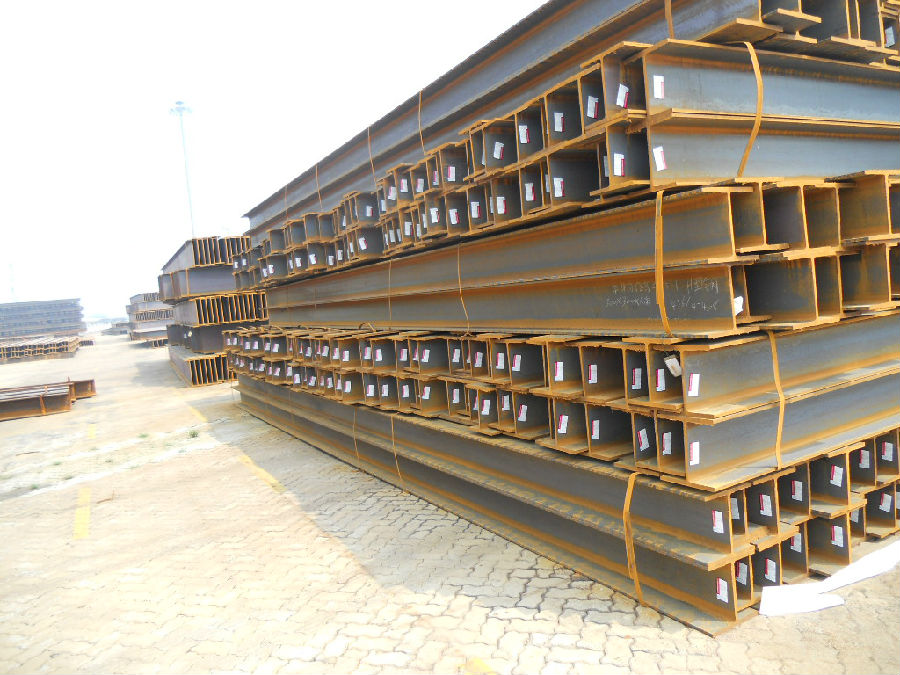
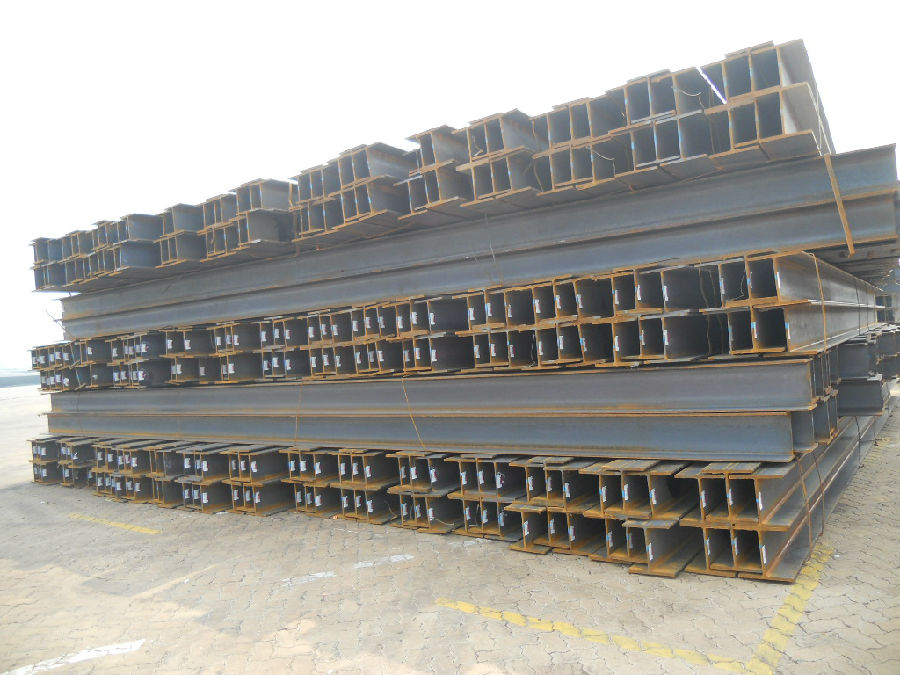
- Q: Are steel H-beams suitable for supporting nuclear power plant facilities?
- Yes, steel H-beams are suitable for supporting nuclear power plant facilities. Steel H-beams are known for their strength, durability, and load-bearing capacity, making them an ideal choice for supporting heavy structures like nuclear power plants. Additionally, steel is resistant to fire, corrosion, and seismic activities, which further enhances its suitability for such critical facilities.
- Q: Are Steel H-Beams resistant to warping or twisting?
- Steel H-Beams possess a high resistance to warping or twisting due to their unique design. The wide flange and vertical web of H-Beams contribute to their exceptional structural stability and ability to withstand bending forces. The symmetrical shape of H-Beams ensures the even distribution of loads, thereby minimizing the risk of warping or twisting. Moreover, H-Beams are commonly manufactured using high-strength steel, enhancing their ability to resist deformation when subjected to heavy loads or external forces. Consequently, Steel H-Beams are an optimal selection for a wide range of applications that demand robust and dependable structural components.
- Q: How do Steel H-Beams compare in terms of lifespan and durability?
- Steel H-Beams are known for their exceptional lifespan and durability. Due to their robust construction and resistance to corrosion, they can withstand extreme conditions, such as heavy loads and harsh weather, without compromising their structural integrity. This makes them highly durable and suitable for long-term use in various applications, including construction and infrastructure projects.
- Q: What are the different connection methods for steel H-beams?
- Depending on the specific application and structural requirements, steel H-beams can be connected using various methods. Here are some commonly used techniques: 1. Welding: Welding is a popular method that involves joining H-beams using techniques like arc welding, gas metal arc welding (MIG), or shielded metal arc welding (stick welding). This creates a strong and rigid connection between the beams. 2. Bolting: Another commonly used method is bolting, where high-strength bolts and nuts are used to connect H-beams. This allows for easy disassembly and reassembly when needed. It's important to ensure the proper bolt size, torque, and spacing to achieve a secure connection. 3. Riveting: Although an older method, riveting is still used in certain cases. It involves drilling holes in the beams and inserting rivets, which are then hammered or compressed to secure the connection. Riveting provides a strong and durable connection, but it is more time-consuming compared to welding or bolting. 4. Moment connections: For structural applications requiring high rigidity and load-bearing capacity, moment connections can be used. These connections are designed to transmit both shear and moment forces between the beams, providing greater stability and resistance to bending moments. 5. Composite connections: In some instances, steel H-beams may need to be connected to other materials such as concrete or timber. Composite connections involve combining the properties of different materials to enhance structural performance. This can be achieved using shear connectors, adhesive bonding, or mechanical fasteners. It's important to note that the choice of connection method depends on factors like load requirements, structural design, available equipment, and the expertise of the construction team. Proper engineering analysis and design are crucial to ensure a safe and efficient connection method for steel H-beams.
- Q: Are steel H-beams resistant to chemicals or corrosive substances?
- Steel H-beams are generally resistant to chemicals and corrosive substances. This is due to the inherent properties of steel, such as its high strength and durability. Steel is known for its resistance to chemical reactions and corrosion, making it a suitable material for various applications in industries where exposure to chemicals or corrosive substances is common. However, it is important to note that the resistance of steel H-beams to chemicals and corrosive substances can vary depending on the specific type of steel used and the nature of the chemicals or corrosive substances involved. In certain extreme conditions or highly aggressive environments, steel may still be susceptible to corrosion or chemical attack. To enhance the resistance of steel H-beams to chemicals and corrosive substances, additional protective measures can be applied. These may include coatings, such as galvanization or paint, which create a barrier between the steel surface and the surrounding environment. Regular maintenance and inspection are also crucial to identify and address any signs of corrosion or chemical damage promptly. Overall, while steel H-beams are generally resistant to chemicals and corrosive substances, it is important to consider the specific application and environment in order to determine the appropriate level of protection and maintenance required.
- Q: Can steel H-beams be used for airport terminals?
- Yes, steel H-beams can be used for airport terminals. Steel H-beams are commonly used in construction projects, including the construction of airport terminals, as they provide structural strength and stability to support the weight of the building and withstand various loads.
- Q: How do you connect steel H-beams together?
- There are several ways to connect steel H-beams, depending on the specific application and load requirements. Here are some commonly used methods: 1. Welding: Steel H-beams can be connected by melting the adjacent surfaces using high heat and allowing them to cool and solidify. This creates a strong bond that provides excellent strength and stiffness. However, skilled welders are needed, and the process can be time-consuming. 2. Bolting: Another popular method is to drill holes through the flanges or webs of the beams and secure them together using bolts and nuts. Bolting offers flexibility as it allows for easy disassembly and reassembly. However, it may not provide the same level of strength as welding, especially for high-load applications. 3. Riveting: An older method involves using metal pins or rivets to connect the steel H-beams. This requires inserting the pins or rivets through pre-drilled holes and deforming the ends to secure them in place. Riveting can provide good strength, but it is less common due to its complexity and time-consuming installation process. 4. Adhesive bonding: In some cases, a strong adhesive can be used to connect steel H-beams. This involves applying the adhesive between the contacting surfaces and allowing it to cure. Adhesive bonding can provide high strength and stiffness, but careful surface preparation is required, and it may not be suitable for all applications. It is important to consider the specific project requirements and consult with structural engineers or professionals to determine the most appropriate method for connecting steel H-beams. Local building codes and regulations may also dictate specific requirements for beam connections.
- Q: What are the limitations of steel H-beams?
- There are several limitations associated with steel H-beams. Firstly, steel H-beams have a relatively high cost compared to other building materials such as wood or concrete. This cost can be a limiting factor for smaller-scale construction projects or those with budget constraints. Secondly, steel H-beams are heavy and require specialized equipment for transportation and installation. This can add complexity and cost to a construction project, particularly if access to the site is challenging or limited. Another limitation is that steel H-beams are susceptible to corrosion, especially in environments with high humidity or exposure to saltwater. Over time, this corrosion can weaken the structural integrity of the beams, leading to potential safety hazards and maintenance requirements. Additionally, steel H-beams have limited design flexibility compared to other materials. They are typically straight and inflexible, making it more challenging to incorporate complex architectural or structural designs. Lastly, steel H-beams have limited fire resistance. Steel is a good conductor of heat, and in the event of a fire, the H-beams can quickly transfer heat throughout the structure, potentially compromising its stability. Fire protection measures such as fireproof coatings or additional fire-resistant materials may be necessary to mitigate this limitation. Overall, while steel H-beams offer many advantages in terms of strength and durability, their limitations in terms of cost, weight, corrosion susceptibility, design flexibility, and fire resistance should be carefully considered when selecting the appropriate building material for a construction project.
- Q: Can steel H-beams be used in retail or shopping mall construction?
- Yes, steel H-beams can be used in retail or shopping mall construction. Steel H-beams are commonly used in construction due to their strength and durability. They provide structural support and can bear heavy loads, making them suitable for large commercial buildings like retail or shopping malls. Additionally, steel H-beams can be easily fabricated and installed, offering flexibility in design and construction. Their use in retail or shopping mall construction ensures a solid and stable framework, allowing for the construction of spacious, open-plan retail spaces and accommodating various architectural designs.
- Q: What are the common finishes available for steel H-beams?
- The common finishes available for steel H-beams include hot-dip galvanizing, primer painting, powder coating, and bare steel.
Send your message to us
Structural carbon steel h beam profile H iron beam (IPE,UPE,HEA,HEB)
- Loading Port:
- Tianjin
- Payment Terms:
- TT OR LC
- Min Order Qty:
- 30 m.t.
- Supply Capability:
- 28000 m.t./month
OKorder Service Pledge
OKorder Financial Service
Similar products
Hot products
Hot Searches
Related keywords
